Worker Wednesday

Gift of Earl and Elaine Buras, 1999.060.006
Seventy years ago, Delta Shipbuilding Co. in New Orleans launched their fifth Liberty ship, the SS Theodoric Bland.
Post by Curator Content/Specialist Kimberly Guise.


Gift of Earl and Elaine Buras, 1999.060.006
Seventy years ago, Delta Shipbuilding Co. in New Orleans launched their fifth Liberty ship, the SS Theodoric Bland.
Post by Curator Content/Specialist Kimberly Guise.
Today is Memorial Day, a day The National WWII Museum takes time to remember the 400,000 men and women who have laid down their lives for our freedom.
Take a moment today to visit mymemorialday.org to see just a few of their stories. Learn about Howard Madison Walker, Germaine Laville, Johnnie David Hutchins and Darrel “Happy” Neil – just a few of our WWII heroes whose stories are part of the Museum’s exhibits and collections.
Look at their photos, see the things they touched and read the letters they wrote home describing the war in their own words.
With your help we can continue our efforts to ensure the voices of these courageous men and women will always be heard. With your contribution of $10 or more today we can digitize artifacts, images and oral histories so they are available for generations to come. Our goal is to raise $40,000 by the end of the day to purchase the software and other tools vital to this effort.
Only a few hours remain for us to meet this challenge. Give your gift today in honor of the brothers, sisters, best friends, husbands and sweethearts who did not return home to their loved ones.
Visit mymemorialday.org today to learn the true purpose of Memorial Day and be sure to share it with your friends and family via Facebook.
Remember Them Today.
On 27 May 1942, the first of seven films in the series Why We Fight was released. Entitled “Prelude to War,” the piece was directed by noted filmmaker Frank Capra who had by then already gained fame with his work on films It Happened One Night and Mr. Smith Goes to Washington, and would go on to direct the Christmas classic It’s a Wonderful Life. For his contributions to the war effort, Capra earned the Distinguished Service Medal in 1945.
An immigrant from Sicily, Capra served in the US Army during World War I and became naturalized shortly thereafter. He reenlisted after Pearl Harbor, offered a commission as a Major at the age of 44. Under normal circumstances, the Signal Corps would have likely been assigned the creation of these films, but with a talent like Capra available, Chief of Staff George Marshall bypassed the Signal Corps and assigned Major Capra the job of creating seven films that would be seen less as propaganda pieces, and more as the inspiring films Capra had proven himself more than capable of making.
The first of the series introduces itself as a film “to acquaint members of the Army with factual information as to the causes, the events leading up to our entry into the war and the principles for which we are fighting.” Prelude to War won the 1942 Academy Award for documentary feature. Many of the subsequent films in the series would use the enemy’s own propaganda films, namely Leni Reifenstahl’s infamous Triumph of the Will. What Germans saw in her film as inspiring and patriotic, Capra turned on its head to show as a frightening force against which America must fight.
This post by Curator Meg Roussel
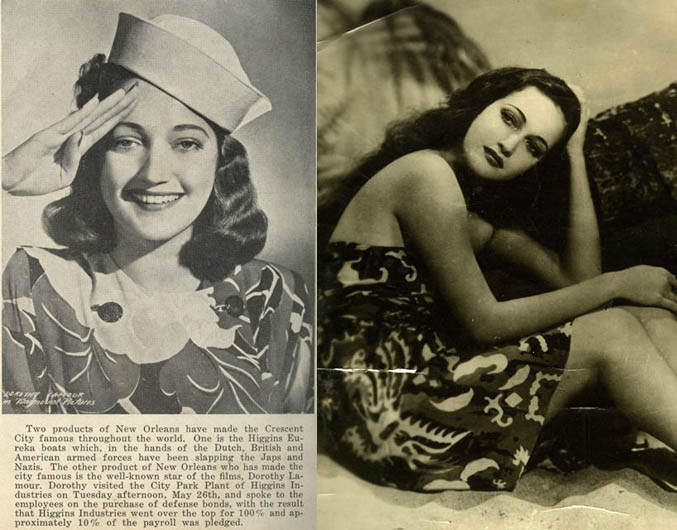
Dorothy Lamour was born Mary Leta Dorothy Slaton in New Orleans in 1914. She lied about her age and won “Miss New Orleans” in 1928. “Miss New Orelans” moved to Chicago and then New York, starting out signing with Rudy Vallee. Her first film was Jungle Princess in 1936, a film that would define her career because her costume was a sarong. Lamour would be known throughout her career as “The Sarong Girl.” During WWII, Lamour was one of the most popular pin-up girls and she traveled the country selling war bonds. She came to be known as the “Bond Bombshell,” selling over $21 million in bonds. On 26 May 1942, Dorothy Lamour traveled back to her hometown to host the Dorothy Lamour Luncheon at the Grand Ballroom at the Roosevelt Hotel. Later that afternoon she visited Higgins Industries. The above-left article is taken from the May 1942 issue of The Eureka News Bulletin from Higgins Industries. Dorothy Lamour died on 22 September 1996.
Post by Curator/Content Specialist Kimberly Guise.
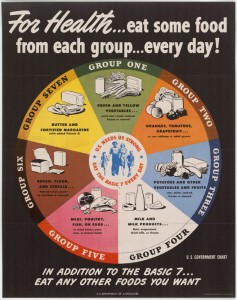
Before food was organized into cohesive groups or placed into a pyramid or a plate, the United States Department of Agriculture introduced the Basic 7 Food Chart. Developed in 1943 as part of the nationwide implementation of wartime food rationing, the “Basic 7” stressed the need to maintain proper nutrition and healthy eating habits that were compatible with the limitation of certain foods. The Basic 7 food groups were:
The USDA stressed the importance of groups one through three not only for their nutritional value, but due to the fact that the foods included could all be grown to some degree in personal Victory Gardens, thus saving ration points for more limited items such as meat and sugar. It is also interesting that butter was a category unto itself.
Share your stories of the Basic 7 Food Chart at our Kitchen Memories site today.
Post by Anna Wysuph, Education Intern at The National WWII Museum
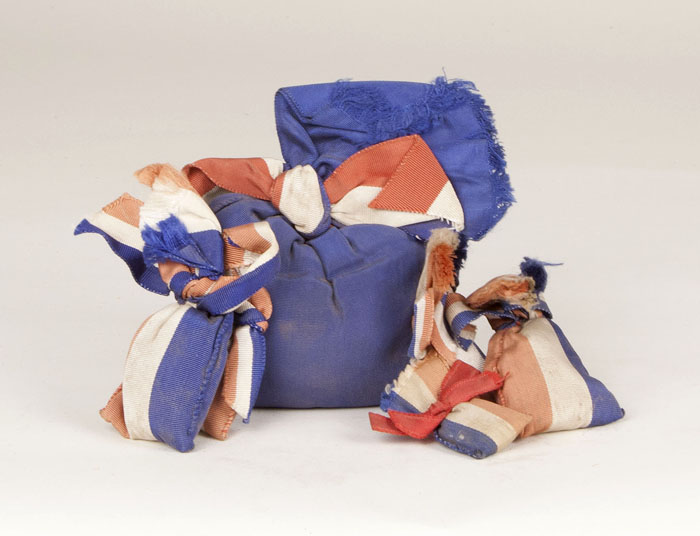
The Museum receives many wonderful donations every week. This past month has offered some particularly exciting material.
How did Mrs. Josie Leggett, the wife of a retired minister, mother of 8, in her sixties from Hattiesburg, Mississippi end up profiled in newspapers across the country, Colliers Magazine and featured on radio shows in the US and Canada.
In 1944, Mrs. Leggett dreamed up a project she would work on for years to come. Her youngest son, Wesley S. Leggett, was serving in the Seventh Air Force in the Marshall Islands when he wrote a letter to his mother in which he expressed how badly he wanted to feel Mississippi soil under his feet again. Mrs. Leggett packaged a scoop of dirt from the family Victory Garden and sent it overseas to her son. Other servicemen in her son’s unit also began requesting soil. Mrs. Leggett then sent some soil to Admiral Nimitz requesting that some be placed on the foundation of the new government building on Kwajalein. Because of the wide reach of the soil project and a desire to have input from states other than her home state of Mississippi , Mrs. Leggett reached out to the governors of all of the states requesting soil from the state capitol grounds. Her tenacity and the correspondence regarding this project is remarkable. The project quickly expanded to other commanders including Lt. General Mark Clark and General Douglas MacArthur and then to US chaplains around the globe who then sprinkled the soil on graves of Americans who were killed overseas. She called her soil bundles “For This We Fight” bags. Josie Leggett’s collection includes the material with which she made her bundles, all of the correspondence related to the project and many news clippings about her and her work. Her story is one of many fascinating stories of people on the Home Front lending their time and support to those fighting abroad.
Click images to enlarge.
Gift in Memory of Josephine Featherstun Legett and Wesley Featherstun Leggett, 2012.
On Memorial Day in 1955, visitors to the Marine Corps Monument in Washington, DC witnessed a symbolic scattering of earth from the capitol grounds of the 48 states, the final presentation of Mrs. Leggett’s soil.
Post by Curator/Content Specialist Kimberly Guise.

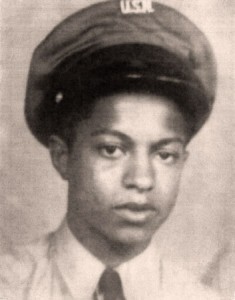 Steward, Third Class Howard Madison Walker from Bowling Green, Kentucky and 78 crewmembers of the submarine USS Tang perished on October 24, 1944, when one of the subs torpedoes malfunctioned and struck her. Approximately 400,000 Americans lost their lives during WWII. Each of these heroes deserves to be remembered — their stories preserved and cherished for generations.
Steward, Third Class Howard Madison Walker from Bowling Green, Kentucky and 78 crewmembers of the submarine USS Tang perished on October 24, 1944, when one of the subs torpedoes malfunctioned and struck her. Approximately 400,000 Americans lost their lives during WWII. Each of these heroes deserves to be remembered — their stories preserved and cherished for generations.
Take a moment today to visit mymemorialday.org to see just a few of these stories which are housed in The National WWII Museum’s exhibits and collections. Look at their photos, see the things they touched and read the letters they wrote home describing the war in their own words.
With your support we can digitize even more artifacts, images and oral histories so they are available for generations to come. Our goal is to raise $40,000 before this Memorial Day — just a few weeks from today. These funds could be used to purchase software and other tools vital to this effort. With your help, we can reach this important milestone.
Visit mymemorialday.org today to learn the true purpose of Memorial Day and be sure to share it with your friends and family via email and social networks.
This Memorial Day, we remember them. We ask you to do the same.
You can also show your support by making a donation today to help us continue preserving the stories of the Greatest Generation.
On 16 May 1942, the Liberty Ship SS Abraham Baldwin, was launched by Delta Shipbuilding Co. in New Orleans.
We have two photographs in our collection that form a “before and after” of the launch.
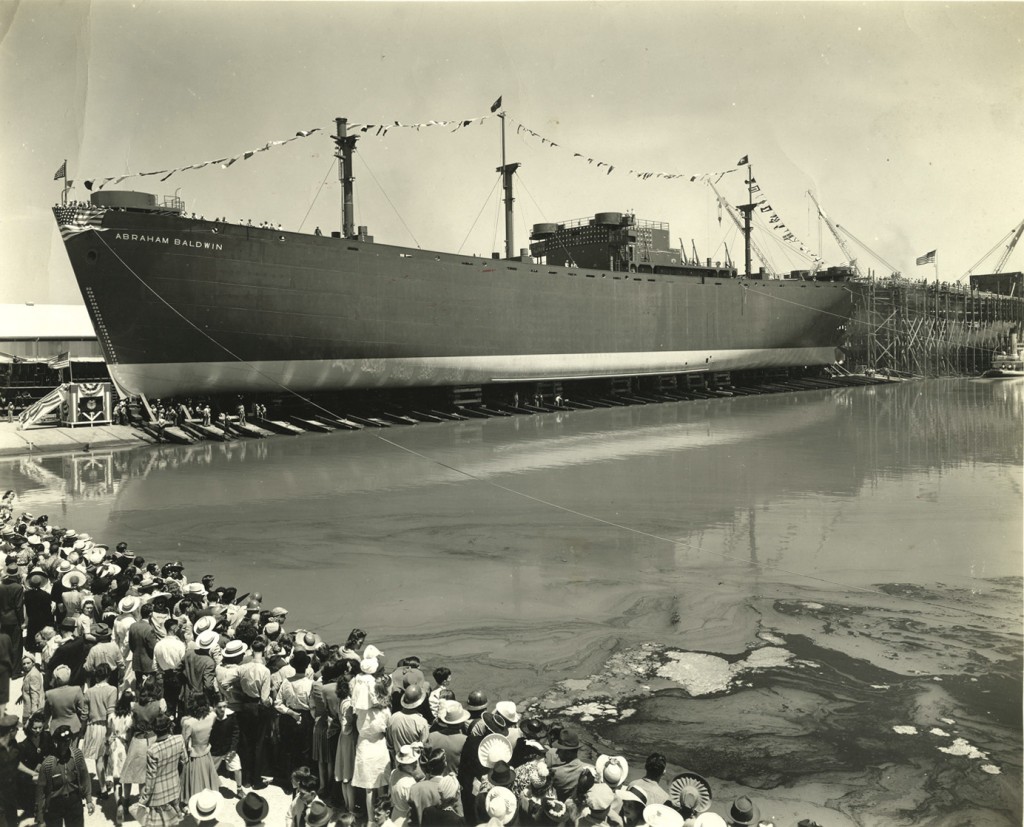
Gift of Earl and Elaine Buras, 1999.060.013

Gift of Jack Hirsch, 2003.022.003
Decades after dodging German U-boats in the Gulf, Liberty ships were intentionally sunk as part of an artificial reef project. The SS Abraham Baldwin was one of the first WWII vessels to be used in such a project in the Gulf of Mexico. She was stripped and sunk off of the coast of Mississippi’s Horn Island in 1976. Artificial reefs, although somewhat contested, have been shown to provide a stable platform for the growth of marine life and aquatic organisms. For more information about Liberty ships serving as artificial reefs see the article, Texas’ Liberty Ships: From World War II Working-class Heroes to Artificial Reefs
Post by Curator Kimberly Guise.
On this day we remember Chief Radio Operator Louis Taix.

Seventy years ago today, on 15 May 1942, twenty-five years old Louis Taix was killed when his ship, the SS Nicarao was torpedoed and sunk by the German submarine, U-571. Taix, the Chief Radio operator on the boat was trapped in the radio shack and went down with the ship as he was sending out cries for help.
Taix had grown up in New Orleans with his siblings and French immigrant parents. It was only after Taix’s death that his parents took steps to become American citizens. Earlier family photos show Louis costuming on Mardi Gras with his family and clowning with his brother, local boxing champ George Taix. Taix’s siblings have often wondered over the years how their lives would be different had their brother survived the war.
Read more about Louis Taix and other stories of sacrifice from the Museum’s Collection at http://mymemorialday.org/remember/taix.php.
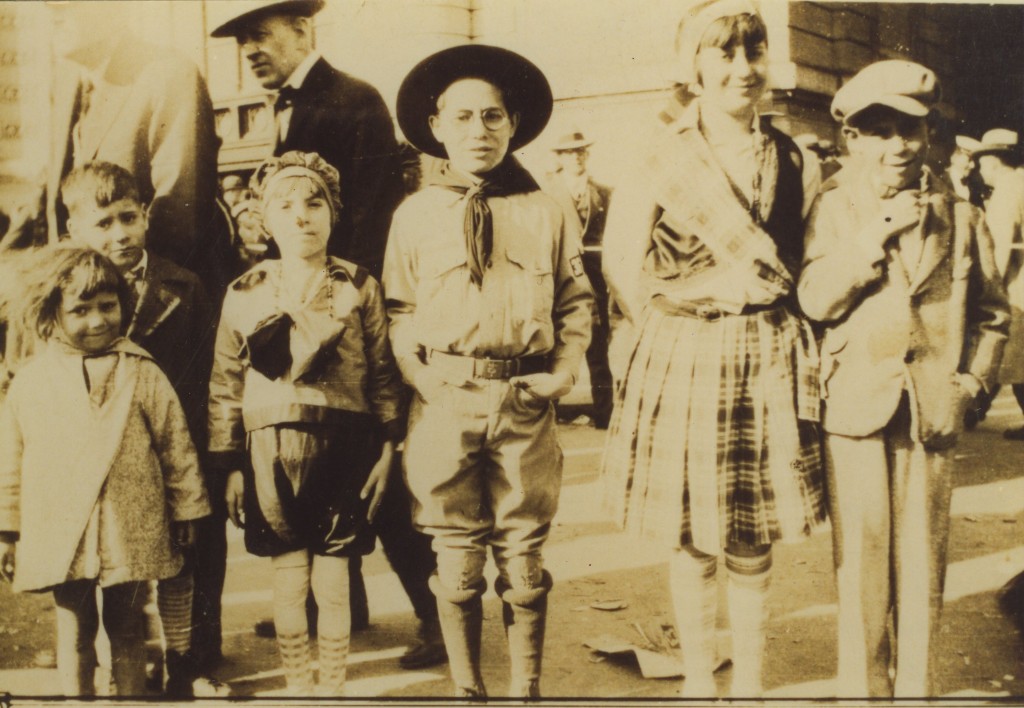
Louis Taix (center) with family on Mardi Gras.
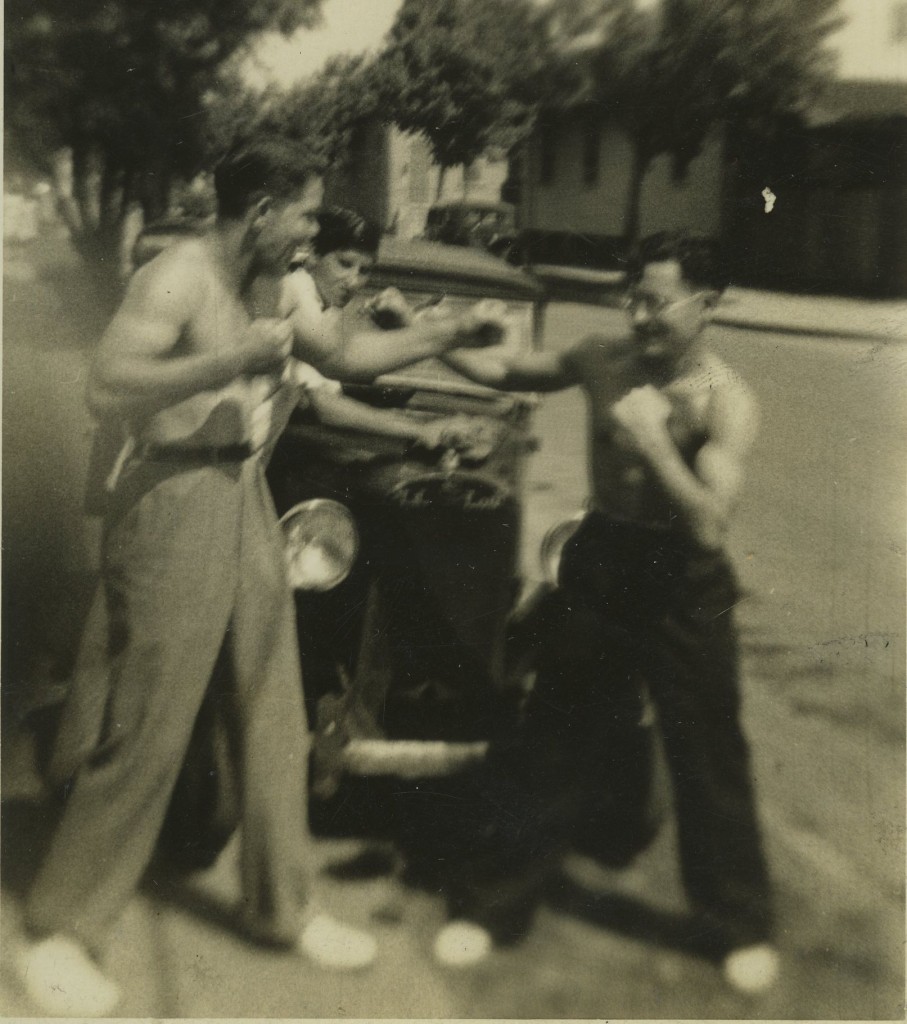
Louis Taix (right) with his brother, George.
Images Courtesy of the Taix Family.
Post by Curator Kimberly Guise.
The National WWII Museum would like to acknowledge and honor the contributions and sacrifices of Jewish Americans during World War II.
The Jewish American experience during World War II was unique. While most Americans saw the defeat of the Japanese as the primary goal of the war, many Jewish American men and women saw the war in a different light. The defeat of Fascism (and in turn the defeat of Hitler) was the primary goal of World War II as they saw it.
Over 500,000 Jewish men and women served in the armed forces. Men saw combat in both the Pacific and European Theaters of War and women served in the WAVES, WACs, WASPS and as nurses overseas. While serving, many Jewish American soldiers faced singular challenges ranging from anti-Semitism to non-kosher meals. Despite these and other challenges, Jewish American servicemen received more than 52,000 awards, including three Medals of Honor.
The collection at The National WWII Museum contains items that belonged to a young Jewish American soldier, Staff Sgt. Milton Miller. Milton Miller was born on November 28, 1918 in Bridgeport, CT. After graduating from the Roosevelt Aviation School in Mineola, Long Island, Miller enlisted in the Army Air Corps and trained at Savannah Army Air Base in Savannah, Georgia. Miller served in the Pacific Theater, Queensland, Australia as part of the “Grim Reapers.” He was killed in action when his plane went down on February 1, 1944.
Gift of Bernice Freedman, 2011.131, Click on images for a larger view.
During the War, the Home Front often proved a space of stark contrasts for Jewish Americans. While worrying over the fate of relatives living in Europe, many Jewish Americans faced anti-Semitic discrimination at home. Despite these hardships, thousands of Jewish Americans served their country on the Home Front by working and volunteering in vital war industries and organizations that supported American servicemen overseas.
Please join The National WWII Museum as it salutes the bravery and sacrifice of Jewish Americans during World War II.
Posted by Laura Sparaco, K-12 Curriculum Coordinator at The National WWII Museum.